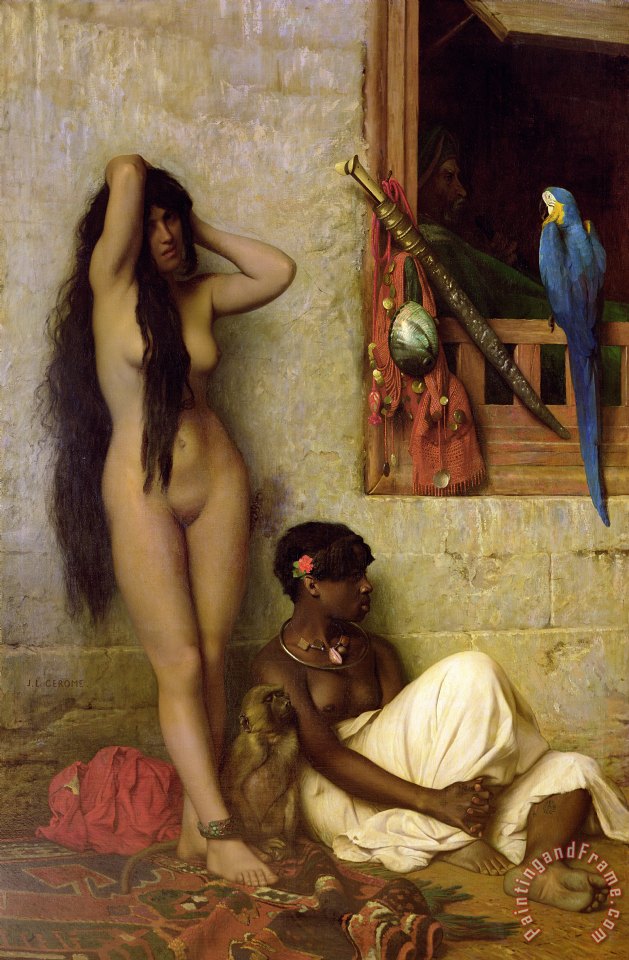They were negresses from
Senaar…apart from this strange physiognomy which nature has endowed them with,
their bodies were a rare of a rare and exceptional beauty; pure and virginal
forms were clearly visible under their tunics; their voices were sweet and vibrant
like the shrill but subdued sounds of fresh mountain springs.
Gérard de Nerval, Voyage en Orient, 1851[1]
Painting
of Two Young Women remains without a certified
author. However, the painter’s enchantment with Dido’s exoticism is easily
acknowledged. The sultry and exotic atmosphere created by placing a
dark-skinned woman next to a fair skinned in intimate scenarios was a constant
juxtaposition in Orientalism. Edward Said stated
that Orientalism is the manner by which the West created a fiction of the ‘Orient’
as a “hotbed of exotic sexuality.” The Orient was not a fixed location but a
combination of North Africa, the Holy Land, and Near East Mediterranean. Gérôme’s artwork and this painting are a
century apart but both share this Orientalist thematic.

Gérôme’s painting The
Slave for Sale from 1873 portrays a pale Cairene slave completely nude
leaning against a wall as a black Nubian woman sits by her feet baring her
breasts. A man in a turban lurks in the shadows managing the two women for sale
– this is an overt representation of the “vulgarities of human trafficking” and
the racial dynamics that come into play. There are indirect allusions to the
power struggled between colonists and colony; criticism of slavery; and extreme
sexualization of the female body. Therefore, these painting asserted white,
male European cultural domination over women and colonials. The two women in The Slave for Sale are displayed in a consumerist
way for male European eyes by their passive and sexually available stand – both
are naked, their shoulders are slumped, and have submissive looks on their
faces.
The
Nubian woman in The Slave for Sale is
saturated with elements that European audiences in the 19th and 20th
centuries would associate with the Orient: Tribal necklaces, white tunics, monkeys,
and flowers. This character embodies servitude, sexuality, and barbarism and,
by association, the Orient is also defined as such. Gérôme, like in Painting
of Two Young Women, has the black woman
as a powerful, elegant figure that is intricately ornamentalized. The idea of
black slave servants was associated with a sumptuous life during that period in
Europe - it was a trendy possession in aristocratic households. Therefore, a
darker servant indicated wealth, prestige, and luxury consumption. There are
art critics as Shudlham who claim the white woman is an allusion to Eve – “honestly
naked, yet sadly destined for the corruption of Oriental slavery.” This Nubian
woman in Gérôme’s painting was disseminating the idea of racialized exotica in
the 20th century in Europe and America.
There
are multiple parallels between Painting of Two Young Women and The Slave for Sale:
Both display a power dynamic and sexual mood between two women of different
skin tones. Painting of Two Young Women is obviously chaster considering it takes place in the
English countryside in 1779; however, all the themes previously discussed are
hinted in Belle’s painting. Belle is presented as an exotic figure by her
ethnic attire combine with her direct gaze at the viewer, what only highlights
her cousin Elizabeth’s chastity and sweetness. Gérôme and the unknown author helped disseminate this aura of mystique
and sexuality aligned with African-European connections in 20th
century Europe.
Works Cited
Childs, Adrienne L., and Susan Houghton Libby.
"Exceeding Blackness: African Women in the Art of Jean-Léon Gérôme."
Blacks and Blackness in European Art of the Long Nineteenth Century.
Burlington: Ashgate Limited, 2014. N. pag. Print.
[1] Childs, Adrienne L’s translation; Gérard de Nerval, Voyage en
Orient (Paris: Gallimard, 1998), 221.
No comments:
Post a Comment